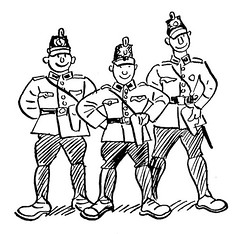Famous Bolshevik feminist Alexandra Kollontai wrote an article in 1918 about "the New Woman" as a literary character in her revolutionary work The New Morality and the Working-Class. Some of her summaries of different "New Women" in contemporary novels remind me of Goldenbird characters! I haven't read any of the quoted books before, so I hope that this is a sign of "being in touch with the Zeitgeist", not plagiarism...
In Colette Yver's The Princesses of Science (1907), Kollontai finds a Goldie lookalike:
In Colette Yver's The Princesses of Science (1907), Kollontai finds a Goldie lookalike:
[...] the woman doctor Laucorojelo, the typical single woman, strides with sure step, her beautiful head held high. Science and the practice of medicine constitute the substance of her life. The clinical wards are at once her temple and her home. She fights for recognition and respect among her male colleagues; gently but unyieldingly she rejects all attempts to win her over to marriage. She needs to be free and alone for her beloved activity, without which she cannot live. She is severe in dress, she apportions her time strictly, she struggles to acquire a practice and experiences the triumph of self-love with the victory over her male colleagues as diagnostician.
Mayann is easily recognizable in the summary of Grete Meisel-Hess' heroine Maya in The Voice (Die Stimme, 1919):
The restless, temperamental Maya's impetuously pushes forward. She has an ironical disposition. To her, all experiences are but stages on the way to herself – to the shaping of her personality: struggle with her relatives for independence, separation from the first husband, a brief romance with an Oriental hero, a second marriage [Cut! Cut! Don't spoil the story for us, Comrade Kollontai!] until Maya finally finds the man who exhibits respect for her inner "voice," this symbol of personality, who recognizes her importance and knows how to create an inwardly free love bond about which Maya has dreamt all her life.
[...] Unconsciously, she follows Goethe's counsel: "to begin one's life anew every day, as though it were just beginning ..." "My stronger, more courageous will, which nothing could break, saved me – my unconscious will to self-preservation. It led me through life like a guardian angel," says Maya of herself.
But where's Lou?...
Although Kollontai made an important point about the "New Woman's" independent attitude in relationships with men, this "New Woman" still maintained relationships to men and was defined by them as modern and "single". Even the woman doctor mentioned above had a harmonious long-distance relationship, which transformed her to a "feminine" creature in private life. Thus, there is no place for Lou among Kollontai's "New Women", because Lou essentially refuses to be defined through heterosexual relationships. (She certainly has male friends like Andy, but she insists in treating them according to the rules of "male" friendship, whether they like it or not.) But Lou would never say: "I curse my female body; because of it you do not notice that there is still something else in me – something more valuable", as one heroine exclaims. She dresses in men's clothes to get attention, not to avoid it. This makes her a *real* New Woman in the sense of Kollontai's conclusion:
Although Kollontai made an important point about the "New Woman's" independent attitude in relationships with men, this "New Woman" still maintained relationships to men and was defined by them as modern and "single". Even the woman doctor mentioned above had a harmonious long-distance relationship, which transformed her to a "feminine" creature in private life. Thus, there is no place for Lou among Kollontai's "New Women", because Lou essentially refuses to be defined through heterosexual relationships. (She certainly has male friends like Andy, but she insists in treating them according to the rules of "male" friendship, whether they like it or not.) But Lou would never say: "I curse my female body; because of it you do not notice that there is still something else in me – something more valuable", as one heroine exclaims. She dresses in men's clothes to get attention, not to avoid it. This makes her a *real* New Woman in the sense of Kollontai's conclusion:
The influence of women earning their own livelihood spreads far beyond their own circle. With their criticism, they "poison" the minds of their contemporaries, they smash old idols, they raise the banner of revolt against those "truths" with which women have lived for generations.






